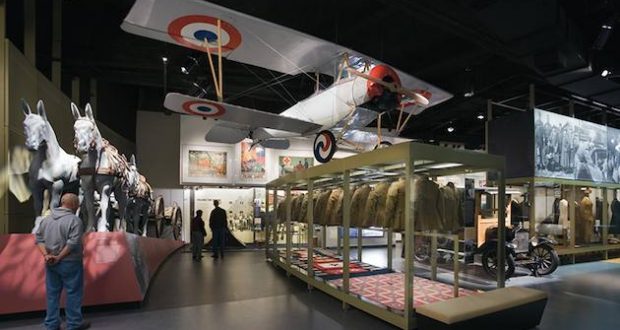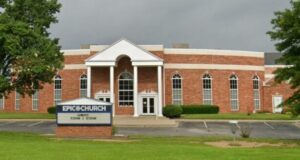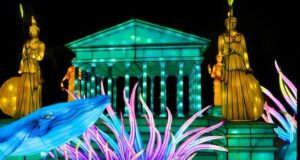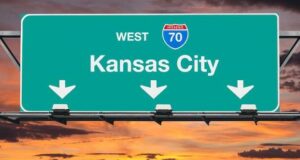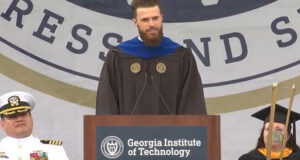It has been some time since I had the unforgettable experience of enjoying the National World War I Memorial and Museum in Kansas City. Known locally as Liberty Memorial, the towering edifice is an iconic part of the Kansas City skyline and has been since the 1920s. Built on a bluff, its 200 foot height made it the tallest structure until replaced by the modern skyscrapers that went up in the 1930s.
Underneath Liberty Memorial which, by the way, you can take an elevator to the top and then climb stairs to the uppermost landing, lies one of the best museums honoring our war heroes and the national war effort in the Great War–later renamed World War I.
The museum and memorial holds the most comprehensive collection of World War I objects and documents in the world and is the second-oldest public museum dedicated to preserving the objects, history and personal experiences of the war.
That war marked a turning point for our nation and how it viewed itself, as well as how the rest of the world viewed us. America was forced into the war after Germany began destroying the world’s merchant fleet that was resupplying England. But after 30% of the world’s civilian fleet was destroyed it still took one more thing to bring us into the war. Germany had sent a secret cable to Mexico to ask them to join the axis powers and, in return, Germany would support financially Mexico’s war on the U.S. and guarantee the return of Texas, New Mexico and Arizona to the Mexican nation.
So high were the tensions between Mexico and the U.S. during that period, Germany almost convinced them. The telegram to the Mexican president was intercepted, decoded and published in American newspapers. The public immediately demanded action. It is a reminder that Mexico has long been an issue for the U.S. and not just the current administration.
The United States was a melting pot then, as it is today. Our armed services were made up of millions of men who were the children of immigrants, or immigrants themselves–though immigrants who had entered the country legally. So great a respect did they have for American ideals and values, they chose to go through the long process of seeking citizenship instead of illegally crossing borders.
Many of those immigrants were Jews from Central and Eastern Europe. Plagued by persecution for 2,000 years in the heart of Europe, Russia and elsewhere, many Jews fled to the U.S. even though as a culture, we still dealt with bigotry, intolerance and racism. At least here, they believed, there would be no wholesale slaughter of Jewish populations as was the case in most of eastern Europe and Russia.
That journey of Jews from Europe to America and their ultimate journey back to Europe to fight for America in World War I are detailed in a new special exhibit at the museum.
For Liberty: American Jewish Experience in WWI, hailed by the New York Times as “remarkably prescient,” opens last Friday, June 29 in the Wylie Gallery. The exhibition provides an in-depth look of what life was like for Jewish Americans on the homefront and for the nearly 250,000 people who served in the American Expeditionary Forces through remarkable stories and artifacts. Featured items include Irving Berlin’s draft registration card and the handwritten draft of Leon Simon’s 1917 Balfour Declaration, a public statement from the British government that helped lay the foundation for the establishment of a Jewish state. The exhibition is open through the centennial of Armistice Day on Nov. 11, 2018.
In conjunction with For Liberty: American Jewish Experience in WWI, the Museum and Memorial will host a free program on American Jews in WWI on Monday, July 16 at 6:30 p.m. Award-winning scholar and author Michael Neiberg traces the evolution of American Jewish thought from 1914 to 1917 and shows how events in both Europe and the U.S. led American Jews to support America’s entry into the war during the presentation.
The United States’ entrance into World War I in 1917 helped secure Allied victory, effectively “turning the tide” of the war. In honor of the sacrifices of countless Americans – including millions of supporters on the home front – the United States Postal Service unveils its “Turning the Tide” Forever stamp during a free public ceremony featuring dignitaries and officials at 11 a.m. on Friday, July 27.
On the evening prior to the ceremony, Smithsonian National Postal Museum Curator Lynn Heidelbaugh gives an expert talk on wartime letter-writing culture that illuminates the relationships, thoughts and emotions of the authors as they grappled with the effects of World War I. This free program is at 6:30 p.m. on Thursday, July 26.
On Sunday, July 29 at 9 a.m., the Museum and Memorial, in partnership with the Kansas City Automotive Museum, hosts the second annual Great Car Show. The event features hundreds of vehicles of all makes, models and years as well as music, educational displays, food trucks, ride-alongs and more. The show is presented by Aristocrat Motors and benefits both museums. Tickets are $5 for adults and $2 for youth at thegreatcarshow.com.
During World War I, blood was stored for future transfusions for the very first time. In recognition of this life-saving achievement, the Museum and Memorial presents Save a Life: Centennial Blood Drive Donation on Friday, July 6 at 9 a.m. To support those in need – just as the soldiers did 100 years ago – make an appointment at esavealifenow.org. Anyone who signs up to donate will receive two free Kansas City Royals tickets. Walk-ins are also welcome.
At 6:30 p.m. on Tuesday, July 10, the Museum and Memorial welcomes historian and author of Love and Death in the Great War, Andrew Huebner, for an engaging presentation. Americans often heard the tale of their nation’s entry into the war told as a love story as fighting promised to stir “khaki-mad” passions in young women and bolstered romantic credibility to the doughboy. Huebner explores this idea through Missourians Mae and Eliga Dees, suggesting a different tale of war, challenging the romantic ideals of American wartime culture.
On Tuesday, July 17 at 6:30 p.m. the Museum and Memorial partners with the Harry S. Truman Library and Museum to present: “Misreading Russia for 101 Years.” When the Russian czar was overthrown in March 1917, Americans passionately proclaimed it a democratic revolution. This enthusiasm, however, was misguided. Assistant foreign editor for The Washington Post will lead a free program that investigates the fraught relationship between the U.S. and Russia over the past century, exploring Wilson’s policies on behalf of democracy, human rights, and Vladimir Putin. Tickets to this event are free with RSVP at trumanlibrary.org.
Lauded as one of 2017’s must- see movies, Wonder Woman tells an epic story of her rise to power fighting in WWI. The Museum and Memorial hosts a free screening of the film on Tuesday, July 24 at 7 p.m. on the big screen in J.C. Nichols Auditorium. Before the screening, Curator of Education, Lora Vogt, will discuss the real-life wonder woman who served in WWI at 6:30 p.m.
Other events occurring in July include:, the monthly Day in the Life program with Living Historians(10 a.m., July 8), Member Perks: Gallery Chat and Reception (6:30 p.m., July 12), Story Time: Doing Her Bit: A Story About the Woman’s Land Army of America (10:30 a.m., July 14), The Modernist Happy Hour (5:30 p.m., July 26), My Fellow Soldiers: Letters from WWI (6:30 p.m., July 26), Complimentary Tours (2:30 p.m., every Thursday), and Hands-on History (11 a.m., every Saturday).
Kansas Citians may not realize they have such a spectacular memorial and museum right at their fingertips. It truly rivals anything the Smithsonian or other museums could produce.
Make sure you take in all it offers this month.
 Metro Voice News Celebrating Faith, Family & Community
Metro Voice News Celebrating Faith, Family & Community

